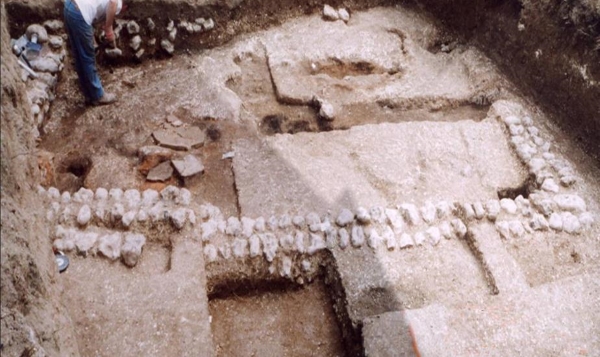
The North Foreland promontory is separated from the downland slopes further to the south by a dry valley, which falls to the cliff line near Stone Bay. In recent time a cutting was made through the cliffs, forming steps and a steep ramp to reach the present shore. In the Roman period there may have been a more gentle slope through the base of the valley, leading to a natural bay located further to the east, which has since been destroyed by coastal erosion.
In the 1920’s O.G.S, Crawford, the great pioneer of British archaeological survey, noted that earthworks and Roman pottery had been found on patch of open downland at Stone Gap , to the north of Broadstairs. No further investigation of the site seems to have taken place before the growing suburbs of Broadstairs eventually enclosed the location within the garden of a bungalow. No attention was drawn to the record of the Roman finds made by Crawford again.
In 2004, the large garden of the bungalow was divided and part was sold to be the location of a new house, to fronting Bishop’s Avenue near its junction with Stone Road. In an archaeological evaluation trench on the site a few scraps of painted plaster were found, with a few Roman and late Iron Age pottery sherds, along with a row of rounded flint cobbles which appeared to be part of a wall. A larger area excavation had to be carried out, which was not an easy task in the very limited space.
Below the deep layer of garden soil that had been distributed over the site to level it, the remains of the basement of a Roman building, an overview of which is shown in today’s image, were uncovered.
The basement had been cut into deep drifts of plough soil which had accumulated on the sloping valley side. The pottery sherds within this soil were almost exclusively of Iron Age date, probably debris from the extensive North Foreland settlement which lies only a short distance to the north of the site. The sides of the rectangular cutting into the soil were lined with large water rolled flint cobbles, bonded with a chalky clay paste.
Many more small painted wall plaster fragments were found in the thin layer of demolition deposits that had been trapped within the rectangular area enclosed by the rounded cobble walls. The lower layers of flooring were revealed to be thick spreads of beaten chalk of variable depth, which sealed two infant burials in one area. The floors seem to have been repaired a number of times in association with the construction and then abandonment of a series of small kilns, which had been fuelled by burning chaff, the fibrous husks separated from harvested grain.
In the latest floor surfaces two more substantial kilns or ovens had been built, the soot from the latest was spread over the clay of the last floor surface. Within the soot a military belt buckle and other small metal items including a spoon, were found, suggesting that clothes or timbers with fittings still attached had been used to fuel the oven.
The Stone Road building provides an intriguing glimpse of a moment in history which can not be fully narrated, but nevertheless generates many associations and speculations. With the limited access to the space in the area of the building and the heavy toll of erosion and damage from subsequent construction work, further archaeological investigation in the future may never be able to answer the many questions raised by this remarkable discovery.
2 thoughts on “VM_365 Day 44 The Romans at Broadstairs 1”